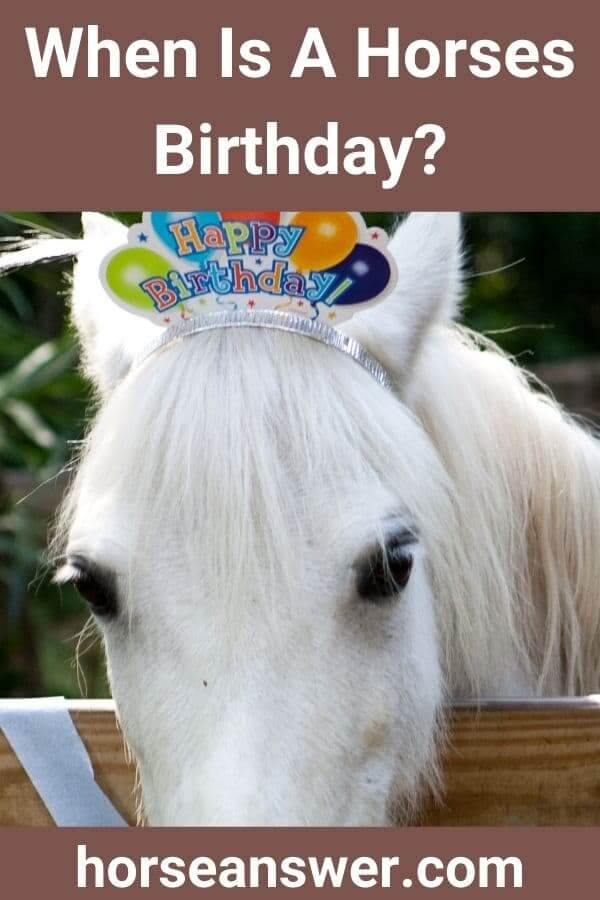When Is A Horses Birthday? (Find Out!)
While out at the races with a friend of mine the other day, we were chatting about the age of a particular horse and I made a passing remark about when its birthday was, as it was just about coming to the age where it would retire from racing.
After my friend laughed and told me, he also said that that was the same as all thoroughbred horses.
I was pretty confused by this, and almost found it hard to believe him, so I did some research of my own.
So, when is a horse’s birthday?
It is different in different hemispheres. Traditionally, in the northern hemisphere, all thoroughbreds celebrate their birthday on January 1st, while all other show horses celebrate their birthday on May 1st. In the southern Hemisphere, Australia in particular, thoroughbreds celebrate their birthday on August 1st.
There are a few different reasons why the industry works in this way, that we will get into.
Obviously, a horse’s actual ‘birthday’ is whatever day it happens to be born.
But horses’ performance can deteriorate a lot as they get older, so setting a standard like this helps keep things even.
Let’s look at why these traditions are in place and where they come from.
Why do all horses have the same birthday?
So, although horses in different hemispheres do have different birthdays, the reasoning is precisely the same.
Thoroughbred horse racing is always age-specific; some are for 2-year-old horses, some for three years old and some for three and up.
If all the administrative staff had to keep track of the actual, individual birthday of every horse in every race, it would be almost impossible.
Eligibility for a race is always determined by age and weight, so keeping the birthdays uniform essentially just helps to manage this.
Breeders usually try to plan so that when they are breeding a mare, the foal will be born after January 1st (or August 1st).
The gestation period for horses is roughly 11 months, so mares are generally bred in mid to late February to conceive the following January.
If things don’t go as planned, however, a foal born early in December would turn 1 year old on the following January, meaning it has essentially lost a year of racing.
The universal birthdays are different in different hemispheres for a couple of reasons that are easy to imagine, but let’s get into it nonetheless.
Why is January a horse’s birthday in the northern hemisphere?
The main reason for the difference in birthdays across hemispheres is the seasons.
Horse in different parts of the seasonal cycle will mate at different times of the calendar year.
In the northern hemisphere, mares typically come into heat after the new year; so, around February.
January 1st, then, makes total sense as a birthdate, given the 11-month gestation period.
So, it’s just a simple fact of convenience and the seasons.
Why is August a horse’s birthday in the southern hemisphere?
The same is more or less true of the August date for horses in the southern hemisphere.
It’s again about breeding cycles and allowing for the standardization of all events.
In Australia particularly, mares come into heat around a month after August, so foals are then born about 11 months later, around August.
Again, it’s really important for breeders to get this timeframe right, as if the foal is born to early, it can have a huge impact on the course of its career, and lose up to a year of racing.
Horse’s racing careers don’t usually last that long in the relative span of their whole lifetime, so let’s look at when horses usually peak.
At what age is a horse fastest?
Different types of racehorses will peak at different ages and have careers that span different lengths of time.
Jump racehorses, for instance, usually don’t even start racing until they’re four, and can have careers that go on until they’re as old as 12.
Ordinary racehorses typically start racing much younger, which is part of why it’s so important to standardize birthdays.
Most flat racehorses can start their career as early as the age of 2, and retire by the time they’re four.
Racehorses involving two-year-old horses are called juvenile races since this is not considered their peak age.
Some racehorses on flat races do go on to race for a lot longer, as old as ten, but this is not typically the case.
Most retire much sooner.
So, most would say that a racehorse reaches its peak at around age 3 or 4.
Jump racehorses, on the other hand, are usually at the peak of their career much later, between 7 and 10.
Jump racehorses require a bit more experience from the horse.
So, most thoroughbreds reach the peaks of their careers quite early and are usually retired to stud farms after that.
It’s almost strange to think that those enormous animals you see barreling down the track faster than you’d drive your car are all juvenile horses.
So, essentially, racehorse birthdays are kept uniform in order to allow for standardization of events and to link up breeding cycles of the animals.
It’s really important to know a racehorse’s age for breeding and fair racing, and also having a standardized birthday means no one can be deceitful about the age of their horse in order to get an unfair advantage.
